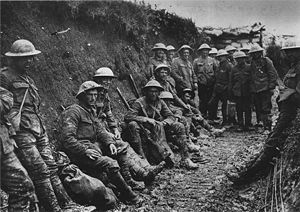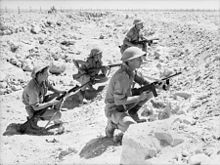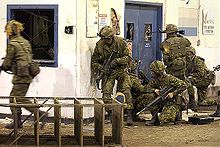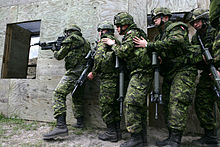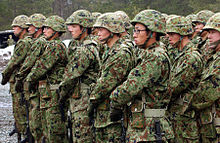- Infantry
-
Lists
Portal Infantrymen are soldiers who are specifically trained for the role of fighting on foot to engage the enemy face to face and have historically borne the brunt of the casualties of combat in wars. As the oldest branch of combat arms, they are the backbone of armies. Infantry units have more physically demanding training than other branches of armies, and place a greater emphasis on discipline, fitness, physical strength and aggression.
Infantrymen are distinguished from soldiers trained to fight on horseback (cavalry), in tanks, or in technical roles such as armourers or signallers, but basic infantry skills are fundamental to the training of any soldier, and soldiers of any branch of an army are expected to serve as auxiliary infantry (e.g., patrolling and security) when necessary. Infantry can access and maneuver in terrain inaccessible to vehicles and tanks, and employ infantry support weapons that can provide firepower in the absence of artillery.
Since the end of the Second World War the infantry has become a smaller part of armies of the Western world, constituting typically between 10% and 30% of an army's personnel. Despite still often representing the largest individual arm, with the exception of logistics, this is vastly reduced from pre-war levels. For instance, in the United States Army of 2009 there were only approximately 49,000 infantrymen[1] out of about 450,000 active duty enlisted personnel.[2]
This reflects the greatly increased requirement for technical and logistical specialists in Western armies, resulting from the increasing complexity of military technology and equipment and an increased recognition of the importance of logistics in warfare. In armies of developing world nations, infantry still accounts for a majority of soldiers, but they are often lacking adequate training in infantry tactics and resources to be as effective as other infantry.
Contents
History
Main article: History of infantry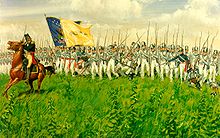 Winfield Scott leading a line of American infantry at the Battle of Chippawa during the War of 1812.
Winfield Scott leading a line of American infantry at the Battle of Chippawa during the War of 1812.
Although the use of the term infantry in English dates from the 16th century, the foot troops of the previous eras in history who fought with a variety of weapons before the introduction of the firearms are also referred to as infantry. During the Ancient and Middle Ages Infantry were categorized by the types of weapons and armour they used, such as heavy, medium, and light infantry. Since the introduction of firearms classifications have changed initially to reflect their formations on the battlefield as line infantry, and later to reflect modes of transport and type of tactics used by specific units as Mechanized infantry or airborne infantry.
Role
The role of the infantry is generally defined as being to destroy the enemy under any conditions, for example:
- The Canadian Army Infantry role is described as: "To close with and destroy the enemy, by day or by night, regardless of season, weather or terrain."[citation needed]
- The Australian Army defines the role of the infantry thus: "The role of the Infantry is to seek out and close with the enemy, to kill or capture him, to seize or hold ground and repel attack, by day or night, regardless of season, weather or terrain."[3]
- The United States Army describes the mission of infantry: "The Infantry closes with the enemy by means of fire and maneuver in order to destroy or capture him or to repel his assault by fire, close combat, and counterattack."{FM7-8, Infantry Rifle Platoon And Squad}
- The infantry mission is "to close with and engage the enemy in all operational theatres and environments in order to bring about his defeat"[citation needed]
All things considered these synopsize what the infantry does and has done throughout the ages, regardless of nationality, changes in technology, doctrine, tactics, etc.
Organization
Infantry is notable by its reliance on organized formations to be employed in battle. These have been developed over time, but remain a key element to effective infantry development and deployment. Up into the 20th century, infantry units were for the most part employed in closely organized formations up until the actual moment of contact with the enemy. This was necessary to allow commanders to retain control of the unit, especially while maneuvering, as well as allowing officers to retain discipline amongst the ranks.
With the development of weapons with increased firepower, it became necessary to disperse soldiers in infantry units to make them less susceptible to high explosive and rapid fire weapons. From World War I, it was recognized that infantry were most successfully employed when using their ability to maneuver in constricted terrain and evade detection in ways not possible for other weapons such as vehicles. This decentralization of command was made possible by improved communications equipment and greater focus on small unit training.
Among the various subtypes of infantry is 'Medium infantry.' This refers to infantry which are less heavily armed and armored than heavy infantry, but more so than light infantry. In the early modern period, medium infantry were largely eliminated due to discontinued use of body armour up until the 20th century. In the United States Army, Stryker Infantry is considered Medium Infantry, since they are "heavier" than light infantry but "lighter" than mechanized infantry.
Doctrine
Infantry doctrine is the concise expression of how infantry forces contribute to campaigns, major operations, battles, and engagements. It is a guide to action, not hard and fast rules. Doctrine provides a common frame of reference across the military forces allowing the infantry to function cooperatively in what is now called combined arms operations. Doctrine helps standardize operations, facilitating readiness by establishing common ways of accomplishing infantry tasks. Doctrine links theory, history, experimentation, and practice. Its objective is to foster initiative and creative thinking in the infantry's tactical combat environment.
Doctrine provides the infantry with an authoritative body of statements on how infantry forces conduct operations and provides a common lexicon for use by infantry planners and leaders. Until development of effective artillery doctrines, and more recently precision guided air delivered ordnance, the most important role of the infantry has been as the primary force of inflicting casualties on the enemy through aimed fire. The infantry is also the only combat Arm which can ultimately decide whether any given tactical position is occupied, and it is the presence of infantry that assures control of terrain. While the tactics of employment in battle have changed, the basic missions of the infantry have not.
Operations
Attack operations are the most basic role of the infantry, and along with defense, form the two primary stances of the infantry on the battlefield. Traditionally, in an open battle, or meeting engagement, two armies would maneuver to contact, at which point they would form up their infantry and other units opposite each other. Then one or both would advance and attempt to defeat the enemy force. The goal of an attack remains the same: to advance into an enemy-held objective and dislodge the enemy, thereby establishing control of the objective.
Attacks are often feared by the infantry conducting them because of the high number of casualties suffered while advancing under enemy fire (mechanized infantry are considered in assaulting positions in contrast to light infantry because of armoured protection and high mobility). Successful attacks rely on sufficient force, preparative reconnaissance and bombardment, and retention of unit cohesion throughout the attack. A subcategory of attacks is the ambush, where infantry lie in wait for enemy forces before attacking at the most vulnerable moment.
Defense operations are the natural counter to attacks, in which the mission is to hold an objective and defeat enemy forces attempting to dislodge the defender. Defensive posture offers many advantages to the infantry, including the ability to use terrain and constructed fortifications to advantage and the reduced exposure to enemy fire compared with advancing forces. Effective defense relies on minimizing losses to enemy fire, breaking the enemy's cohesion before their advance is completed, and preventing enemy penetration of defensive positions.
Patrol is the most common infantry mission. Full scale attacks and defensive efforts are occasional, but patrols are constant. Patrols consist of small groups of infantry moving about in areas of possible enemy activity to discern enemy deployments and ambush enemy patrols. Patrols are used not only on the front-lines, but in rear areas where enemy infiltration or insurgencies are possible.
Pursuit is a role that the infantry often assumes. The objective of pursuit operations is the destruction of enemy forces which are not capable of effectively engaging friendly units before they can build their strength to the point where they are effective. Infantry traditionally have been the main force to overrun these units in the past, and in modern combat are used to pursue enemy forces in constricted terrain (urban areas in particular), where faster forces, such as armored vehicles are incapable of going or would be exposed to ambush.
Escort consists of protecting other units from ambush, particularly from other infantry. This is one of the most important roles for the modern infantry, in particular when operating along side armored vehicles. In this capacity, infantry essentially conducts patrol on the move, scouring terrain which may hide enemy infantry waiting to ambush friendly vehicles, and identifying enemy strong points for attack by the heavier units.
Maneuver operations consume much of an infantry unit's time. Infantry, like all combat units, are often maneuvered to meet battlefield needs, and often must do so under enemy attack. The infantry must maintain their cohesion and readiness during the move to ensure their usefulness when they reach their objective. Traditionally, infantry have relied on their own legs for mobility, but mechanised or armoured infantry often uses trucks and armored vehicles for transport, leaving the light infantry to jobs which they cannot access.
Reconnaissance/intelligence gathering Surveillance operations are often carried out with the employment of small recon units or sniper teams which gather information about the enemy, reporting on characteristics such as size, activity, location, and equipment. These infantry units typically are known for their stealth and ability to operate for periods of time within close proximity of the enemy without being detected. They may engage high profile targets or be employed to hunt down terrorist cells and insurgents within a given area. These units may also entice the enemy to engage a located recon unit thus disclosing their location to be destroyed by larger combat assault forces.
Reserve assignments for infantry units involve deployment behind the front, although patrol and security operations are usually maintained in case of enemy infiltration. This is usually the best time for infantry units to integrate replacements into units and to maintain equipment. Additionally, soldiers can be rested and general readiness should improve. However, the unit must be ready for deployment at any point.
Construction can be undertaken either in reserve or on the front, but consists of using infantry troops as labor for construction of field positions, roads, bridges, airfields, and all other manner of structures. The infantry is often given this assignment because of the physical quantity of men within the unit, although it can lessen a unit's morale and limit the unit's ability to maintain readiness and perform other missions. More often, such jobs are given to specialist engineering corps.
Base defense is where infantry units are tasked to protect certain areas like command posts or airbases. Units assigned to this job usually have a large amount of military police attached to them for control of checkpoints and prisons.
Raid/Hostage Rescue Infantry units are trained to quickly mobilize, infiltrate, enter and neutralize threat forces when appropriate combat intelligence indicates.
Daily life
Because of the very nature of the work; with firearms, explosives, physical-emotional stress, and genuine violence, casualties and or deaths are not uncommon in both war and in peacetime training or operations.
The physical demands are extreme. All of the combat necessities such as ammunition, weapon systems, food and clothing and shelter are literally carried on the backs of the infantrymen. Combat loads of 80lbs are common and greater loads in excess of 100lbs are not unheard of. [1] These heavy loads, combined with long forced foot marches and patrols of up to 25 miles a day, in any climate from 110 degree heat, to -20 degree cold, there is no escape from the elements, ensure the development of strong bonds and mutual respect between infantrymen, in and out of the armed services. [2]
Despite these extreme physical demands, an infantryman is expected and highly trained to continue on with the mission despite personal fear, despair, fatigue and injury. This is exemplified in the United States Army by an excerpt from the infantryman's creed
In the race for victory, I am swift, determined, and courageous; Armed with a fierce will to win. Never will I fail my country's trust. Always I fight on: through the foe, to the objective, to triumph over all. If necessary, I fight to my death.[4]
United States Army Rangers, a specialised light infantry, have their own Ranger Creed that demands faithful service from the infantryman even "...though I be the lone survivor."
Though the skill of infantry has no direct civilian correlation, valuable life skills that cannot be taught in any classroom, such as discipline, courage, team work, initiative, loyalty, trust, empathy, stress management, "lead by example" leadership, as well as many others contribute to the success that many face in the civilian world regardless of occupation. [3]
Work with individial and crew served weapon systems, combatives, sensitive information, and the rigors of the job make infantrymen good recruitment candidates for government and private police and intelligence agencies, especially if the individual has attained other important skills in language computers and public policy.
Equipment
The equipment of infantry forces has evolved along with the development of military technology in general, but certain constants remain regarding the design and selection of this equipment. Primary types of equipment are weaponry, protective gear, survival gear, and special equipment.
Infantry weapons have included all types of personal weapons, i.e., anything that can be handled by individual soldiers, as well as some small crew-served weapons that can be carried. During operations, especially in modern times, infantry often scavenge and employ whatever weapons they can acquire in addition to those given them by their supply chain.
Infantry from ancient times up until the modern age have wielded a wide array of weaponry. Infantry used all sorts of melee weapons, such as various types swords, axes, and maces, as well as ranged weapons such as javelins, bows, and slings. Infantry of these periods also often wore varying types of armor, including chain mail and Cuirasses. Many of their weapons evolved over time to counter advances made in armor, such as the falchion, whose heavy blade was designed to break chain mail armor.
Modern infantry weaponry include rifles, grenades, sub machine guns, machine guns, shoulder-fired rocket launchers and missiles, and lighter mortars and grenade launchers. Modern infantry are often equipped with helmets, a gas mask, and in some cases, additional body armor.
Protective equipment and survival gear
Infantry protective gear includes all equipment designed to protect the soldier against enemy attack. Most protective gear comprises personal armor of some type. Classical and medieval infantry employed leather and metal armor as defense against both ranged and melee attacks, but with the advent of firearms, such armor could no longer defeat attacks and was discarded. The return to use of the helmet was prompted by the need to defend against high explosive fragmentation, and further developments in materials led to effective bullet-defeating armor within the weight acceptable for infantry use. The use of body armor is again becoming widespread amongst infantry units, primarily using Kevlar technology. Infantry must also often carry protective measures against chemical and biological attack, including gas masks, counter-agents, and protective suits.
Infantry survival gear includes all of the items soldiers require for day-to-day survival in the combat environment. These include basic environmental protections, medical supplies, food, and sundries. As the amount of equipment a soldier can carry is very limited, efforts have been made to make equipment light and compact. Equipment is carried in tactical gear (such as ALICE), which should be comfortable to wear for extended periods of time, hamper movement as little as possible and be compatible with other things a soldier can be expected to carry, such as field radios and spare magazines. infantry have suffered large casualty rates from disease, exposure, and privation—often in excess of those suffered from enemy attacks. Better equipment of troops in this area greatly reduce this rate of loss. One of the most valuable pieces of gear is the entrenching tool - basically a collapsible spade — which can be employed not only to dig important defenses, but also in a variety of other daily tasks and even as a weapon.
Specialized equipment consists of a variety of gear which may or may not be carried depending on the mission and the level of equipment of an army. Communications gear has become a necessity, as it allows effective command of infantry units over greater distances. In some units, individual communications are being used to allow the greatest level of flexibility. Engineering equipment, including demolitions, mines, and other gear, is also commonly carried by the infantry or attached specialists. A variety of other gear, often relating to a specific mission, or to the particular terrain in which the unit is employed, can be carried by infantry units.
Historical descriptions
- "Let us be clear about three facts: First, all battles and all wars are won in the end by the infantryman. Secondly, the infantryman always bears the brunt. His casualties are heavier, he suffers greater extremes of discomfort and fatigue than the other arms. Thirdly, the art of the infantryman is less stereotyped and far harder to acquire in modern war than that of any other arm."[5] Field Marshal Earl Wavell
- "I love the infantry because they are the underdogs. They are the mud-rain-frost-and-wind boys. They have no comforts, and they even learn to live without the necessities. And in the end they are the guys that wars can't be won without."[6]Ernie Pyle
- "I'm convinced that the infantry is the group in the army which gives more and gets less than anybody else."[7] Bill Mauldin, Up Front (1945)
- "Never think that war, no matter how necessary, nor how justified, is not a crime. Ask the infantry and ask the dead."[8] Ernest Hemingway[9]
- "The infantry doesn't change. We're the only arm [of the military] where the weapon is the man himself."[10] C.T. Shortis
- "Ah, yes, mere infantry — poor beggars…"[11] Plautus
- "The army's infantry is its most essential component. Even today, no army can take and hold any ground without the use of infantry."[12] George Nafziger
- "The infantry is there so that when some die the generals know where to direct the artillery fire" (anonymous Japanese soldier, Iwo Jima)[verification needed]
- '"Aerial bombardment can obliterate, but only infantry can occupy" - a Finnish Army observation of the Operation Allied Force in the 1990s
- “I don’t know what effect these men will have upon the enemy, but, by God, they terrify me.” - the Duke of Wellington
- "Victory is still measured by foot" - The Indian Army
- “I don’t know why we have the Air Force and Navy. It's always up to the bloody infantry to get the job done." - Australian Soldier At Tobruk[citation needed]
See also
- Airborne infantry
- Light infantry
- Line Infantry
- Mounted infantry
- School of Infantry
- Naval Infantry
Citations and notes
- ^ Careers & Jobs: Infantryman (11B) at GoArmy.com
- ^ Active Duty Military Personnel by Rank/Grade September 30, 2009 DOD
- ^ Royal Australian Corps of Infantry at www.army.gov.au
- ^ Click to view the full text
The Infantryman's Creed
I am the Infantry.
I am my country's strength in war, her deterrent in peace.
I am the heart of the fight - wherever, whenever.
I carry America's faith and honor against her enemies.
I am the Queen of Battle.I am what my country expects me to be - the best trained soldier in the world.
In the race for victory, I am swift, determined, and courageous, armed with a fierce will to win.Never will I fail my country's trust.
Always I fight on - through the foe, to the objective, to triumph over all.
If necessary, I fight to my death.By my steadfast courage, I have won 200 years of freedom.
I yield not-- to weakness,
- to hunger,
- to cowardice,
- to fatigue,
- to superior odds,
- for I am mentally tough,physically strong,
- and morally straight.
I forsake not-
- my country,
- my mission,
- my comrades,
- my sacred duty.
I am relentless.
I am always there, now and forever.I AM THE INFANTRY!
FOLLOW ME![citation needed] - ^ In Praise of Infantry, by Field Marshal Earl Wavell, first published in "The Times," Thursday, 19th April 1945
- ^ p.257, Tobin
- ^ p.5, Mauldin & Ambrose
- ^ p.262, Trogdon
- ^ This was misquoted in We were Soldiers Once...And Young: Ia Drang--The Battle That Changed The War In Vietnam, by Harold G. Moore and Joseph L. Galloway, Random House, 1 ed., 1992
- ^ The New York Times, Shortis
- ^ p.156, Heinl
- ^ p.13, Nafziger
References
- English, John A., Gudmundsson, Bruce I., On Infantry, (Revised edition), The Military Profession series, Praeger Publishers, London, 1994 ISBN 0-275-94972-9
- The Times, Earl Wavell, Thursday, 19 April 1945 In Praise of Infantry
- Tobin, James, Ernie Pyle's War: America's Eyewitness to World War II, Free Press, 1997
- Mauldin, Bill, Ambrose, Stephen E., Up Front, W. W. Norton, 2000
- Trogdon, Robert W., Ernest Hemingway: A Literary Reference, Da Capo Press, 2002
- The New York Times, Maj Gen C T Shortis, British Director of Infantry, 4 February 1985
- Heinl, Robert Debs, Dictionary of Military and Naval Quotations, Plautus in The Braggart Captain (3rd century CE), Naval Institute Press, Annapolis, 1978
- Nafziger, George, Napoleon's Invasion of Russia, Presidio Press, 1998
External links
- In Praise of Infantry, by Field-Marshal Earl Wavell; First published in "The Times," Thursday, 19 April 1945
- The Lagunari “Serenissima” Regiment KFOR: KFOR Chronicle
Wikimedia Foundation. 2010.


